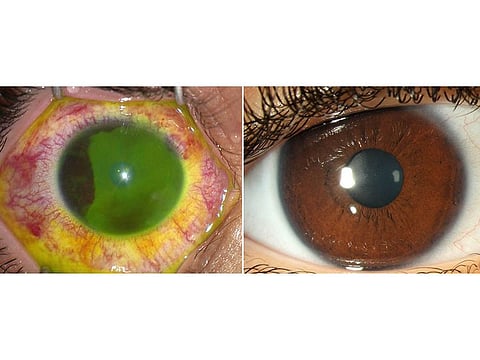Four-year-old girl severely injured in the eye in Abu Dhabi after unintentional exposure to hand sanitiser
Doctor advises parental supervision during use of hand sanitisers by children

Abu Dhabi: A four-year-old girl in Abu Dhabi sustained a severe eye injury after unintentional exposure of her eyes to a hand sanitiser from a self-dispensing unit.
The accident occurred when the child activated a foot-operated hand sanitiser station while visiting a public venue with her family. The girl required immediate treatment, including a follow-up procedure to enable healing in the affected eye.
Parental supervision must
Following the incident, experts who treated her at the Cleveland Clinic Abu Dhabi have urged parents to closely supervise hand sanitiser use among children. Their calls follow similar advice on parental supervision during sanitiser use from ophthalmology experts in France, Spain and India, where similar eye injuries have been reported.
Sudden exposure
The girl’s mother, who wished to remain anonymous, added that many people are unaware about the risks of the chemicals used in hand sanitisers, especially for children.
“For purposes of hygiene, we’ve taught our daughter to use soap and water for washing her hands and to only use sanitisers if soap and water are not available. But because she saw everyone around her use it, she ran up ahead from us to use it too. When she pressed the pedal of the dispenser, the hand sanitiser didn’t fall downwards but instead a large quantity went straight into her eye and she began screaming in pain,” said the girl’s mother.
Her parents immediately rinsed the girl’s eyes with water and took her home, while continuing to wash the affected eyes.
Clear injury
“We were somehow able to open her eye and could see the corneal injury clearly. That is when we decided to rush her to hospital,” the mother said.
In a statement, Cleveland Clinic Abu Dhabi said the child was brought to the Emergency Department complaining of extreme pain and she was unable to open her eye. Doctors immediately washed the solution off, administered antibiotics to prevent infection and gave the young patient pain-healing eye drops. Doctors diagnosed her with a near total corneal abrasion caused by the alcohol and alkaline chemical additives in the hand gel.
Follow-up procedure
When the pain continued to escalate despite close follow-up over the following days, the child was taken to the operating room where doctors evaluated her eye under anaesthesia and placed a self-retaining amniotic membrane, or biological bandage used to heal large non-healing corneal abrasions and scrapes.
The membrane was removed a week after it was placed. While the abrasion had healed, the cornea was still dry and hazy. So the doctors prescribed a course of medicated and lubricant eye drops. Her care team at the hospital will now continue to follow-up on her for the next few months.
Children’s eye injuries
Dr Brian Armstrong, staff physician at the hospital’s Eye Institute, and part of the little girl’s care team, said this was the first case of this nature treated at the hospital that required amniotic membrane placement. However, paediatric eye injuries from alcohol-based hand sanitisers have been on the rise all around the world since the start of the COVID-19 pandemic.
Health authorities have recommended the use of alcohol-based hand sanitisers containing at least 60 per cent alcohol, which disrupt the COVID-19 virus’ surrounding lipid membrane in a manner similar to soap and help inactivate it.
However, the pervasiveness of hand sanitisers has also racked up the number of injuries caused by these substances. Earlier this year, the French Poison Control Centres reported seven times more cases of ocular exposure among children to hand sanitisers between April and August in 2020, compared to the same period in 2019.
High alcohol concentration
“Hand sanitiser dispensers installed in public spaces are often at waist-level for adults, but this means that they are at eye-level for many children. So, the chances of a child getting splashed in the eye are quite high. Most hand sanitisers have a high concentration of alcohol, which starts to break down the surface of the cornea immediately,” Dr Armstrong said.
Supervise children during use
Doctors have advised parents to use soap and water for hand hygiene whenever possible and opt for hand sanitisers only when an alternative is not available.
“When this is not possible, parents should use neutral and natural hand sanitising solutions under strict supervision and teach children to use only a small quantity that dries completely before children touch their eyes. If they happen to rub their eyes with sanitiser, immediately wash them out with water and visit a hospital if there is blurred vision or pain,” Dr Armstrong advised.
Sign up for the Daily Briefing
Get the latest news and updates straight to your inbox








